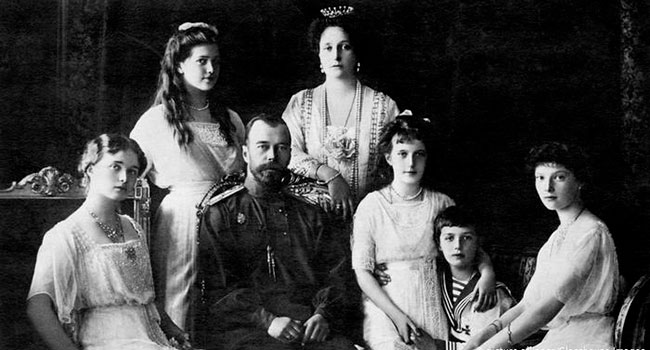 The First World War was a disaster, not just for the millions of battlefield casualties but also for three of the hitherto dominant imperial dynasties.
The First World War was a disaster, not just for the millions of battlefield casualties but also for three of the hitherto dominant imperial dynasties.
Two of the families, the Hohenzollerns of Germany and the Habsburgs of Austria-Hungary, were deposed and exiled. The third, Russia’s Romanovs, experienced a grislier fate.
In March 1917 – 100 years ago this month – Tsar Nicholas II abdicated under extreme pressure. In July of the following year, he and his immediate family were bayoneted, shot, mutilated and secretly buried.
The Romanovs’ reign began in 1613 when the teenager Michael Romanov was elevated to the throne, concluding chaos that had begun 15 years earlier. Known as the Time of Troubles, the 15 years were characterized by civil war, foreign invasion and famine. At the end, the Rurik dynasty was supplanted by the Romanovs.
| RELATED CONTENT |
| Political dynasties: destiny fulfilled or disaster in waiting? By Pat Murphy |
| Hereditary empires and the struggle with modernity By Pat Murphy |
| A love letter from Canadian LGBQT artist to the Queen By Owen Grant Innes |
A recent biographer of the family noted that “It was hard to be a tsar.” Russia was a brutal, backward place with a social pattern marked by “servility to those above, tyranny over those below.” The Russian soul was mystical, religious, superstitious, paranoid and autocratic. In such an environment, perceived weakness could be fatal.
Many of the Romanovs, however, were perfectly capable of stepping up to the autocratic plate.
The laws of the 17th century accentuated the inviolability of the state as exemplified in the tsar. Disrespect could result in having your tongue torn out.
Peter the Great (1672-1725) supplemented his other qualities with an immense capacity for ruthless cruelty. In addition to torturing his son to death, he’s described as “having a beautiful ex-lover beheaded, then lifting her bloodied head, kissing it on the lips and lecturing the crowd on the windpipe and arteries.”
Along with another famous Romanov – Catherine the Great (1729-1796) – Peter was determined to modernize Russia by bringing it into the European mainstream. The intent wasn’t to reduce the power of the tsar but rather to augment it by developing industry, diminishing the power of the Orthodox Church, promoting education, adopting new military technology and reorganizing government.
In the end, though, Peter and Catherine were constrained by Russia’s inherent qualities. Although changes were made and Russia’s territorial reach was extended, a gulf remained between it and western Europe.
Catherine – who was actually German – had another dimension that has titillated people through the centuries. Her sexual appetite was on a par with that of famously licentiousness male monarchs.
While Catherine’s reputed nymphomania may be mere invention, it’s fair to say that she was what modern parlance would define as a cougar. She liked handsome young men and was given to collecting them, enjoying them and then paying them off when she got bored. This propensity continued to the end of her life, her last lover being 40 years her junior.
But unfortunately for the Romanovs, Nicholas II wasn’t cut from the same cloth as Peter, Catherine or his other more imposing predecessors.
Historian Margaret MacMillan describes him this way: “The problem was that Nicholas wanted to conserve the power bequeathed him but he had very little idea of what he wanted to do with it. Nor did he have an ability to pick good advisers or listen to them.” Even into his 20s, his father regarded him as “an absolute child.”
Nicholas was 26-years-old when he came to power in 1894. And very little, if anything, went right for him.
There was the disastrous Russo-Japanese War (1904-1905), the waves of unrest and repression, and finally the catastrophe of the First World War. With more than 1.8 million deaths, the latter’s toll on Russia was exceeded only by that on Germany.
Of the great European imperial houses, the only one to survive the war was the House of Saxe-Coburg and Gotha, which has been known since 1917 as the House of Windsor. Of course, being on the winning side helps. But there was more to it than that.
Beginning with Magna Carta (1215) and continuing through the 17th century deposition of the Stuarts and subsequent reform acts, the English had progressively domesticated their monarchy. By the dawn of the 20th century, the Royal Family reigned but didn’t rule.
Mortally wounded by the First World War, European imperialism was on its last legs, taking a slew of royal dynasties down with it.
Troy Media columnist Pat Murphy casts a history buff’s eye at the goings-on in our world. Never cynical – well, perhaps a little bit. For interview requests, click here.
The opinions expressed by our columnists and contributors are theirs alone and do not inherently or expressly reflect the views of our publication.
© Troy Media
Troy Media is an editorial content provider to media outlets and its own hosted community news outlets across Canada.


